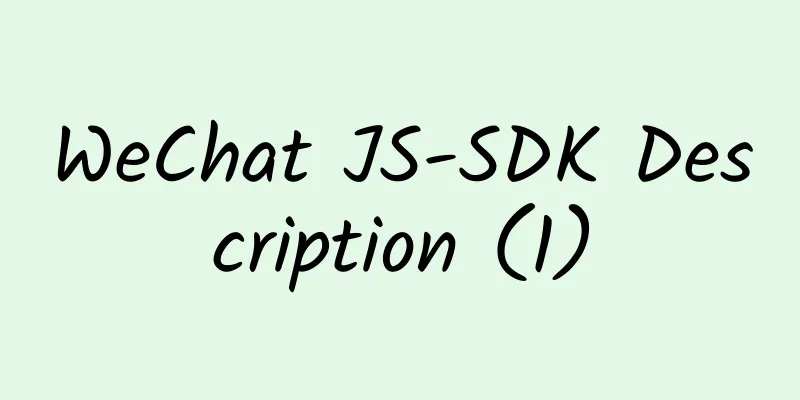WeChat JS-SDK Description (1)

OverviewWeChat JS-SDK is a web development toolkit based on WeChat provided by WeChat public platform for web developers. By using WeChat JS-SDK, web developers can leverage WeChat to efficiently use mobile system capabilities such as taking photos, selecting images, voice, and location. At the same time, they can directly use WeChat-specific capabilities such as WeChat sharing, scanning, cards and coupons, and payment to provide WeChat users with a better web experience. This document introduces how to use WeChat JS-SDK and related precautions for web developers. JSSDK usage stepsStep 1: Bind domain nameFirst log in to the WeChat public platform and enter the "Function Settings" of the "Public Account Settings" to fill in the "JS Interface Security Domain Name". Note: After logging in, you can view the corresponding interface permissions in the "Developer Center". Step 2: Import JS fileIn the page that needs to call the JS interface, introduce the following JS file (supports https): http://res.wx.qq.com/open/js/jweixin-1.0.0.js Note: Supports loading using AMD/CMD standard module loading method Step 3: Inject permission verification configuration through config interfaceAll pages that need to use JS-SDK must first inject configuration information, otherwise they will not be called (the same URL only needs to be called once, and the SPA web app with a changing URL can be called every time the URL changes. Currently, the Android WeChat client does not support the new H5 feature of pushState, so using pushState to implement the web app page will cause signing failure. This problem will be fixed in Android6.2).
wx.config({
debug: true, // Turn on the debug mode. The return values of all API calls will be alerted on the client. If you want to view the incoming parameters, you can open it on the PC. The parameter information will be printed through the log. It will only be printed on the PC.
appId: '', // Required, the public account's *** identifier timestamp: , // Required, the timestamp for generating the signature nonceStr: '', // Required, the random string for generating the signature signature: '', // Required, signature, see Appendix 1
jsApiList: [] // Required, list of JS interfaces to be used. For a list of all JS interfaces, see Appendix 2
});
Step 4: Successfully verify the process through the ready interface
wx.ready(function(){
// After the config information is verified, the ready method will be executed. All interface calls must be made after the config interface obtains the result. Config is a client asynchronous operation, so if you need to call the relevant interface when the page is loaded, you must put the relevant interface in the ready function to ensure correct execution. For interfaces that are called only when triggered by the user, you can call them directly without putting them in the ready function.
});
Step 5: Handle failed verification through the error interface
wx.error(function(res){
// If the config information verification fails, the error function will be executed. For example, if the signature expires, the verification fails. You can view the specific error information by turning on the debug mode of config or in the returned res parameter. For SPA, you can update the signature here.
});
Interface call instructionsAll interfaces are called through wx objects (jWeixin objects can also be used). The parameter is an object. In addition to the parameters that each interface needs to pass, there are also the following common parameters:
Note: Do not try to use ajax asynchronous request in trigger to modify the shared content, because the client sharing operation is a synchronous operation, and the response packet from ajax will not be returned at this time .
When the call is successful: "xxx:ok", where xxx is the name of the called interface. When the user cancels: "xxx:cancel", where xxx is the name of the called interface. When the call fails: its value is the specific error message. |
<<: Data statistics interface - interface analysis data interface
>>: WeChat JS-SDK Description-Open Interface Description
Recommend
The super weapon of element synthesis! See what is the key to artificially synthesizing elements →
Welcome to Science Popularization China’s special...
How to grill elegantly: Why does the smoke always chase me?
Author: New Media Center of Institute of Physics,...
Red Magic 7 gaming phone review: 165Hz gaming screen & extreme heat dissipation, creating a top new Snapdragon 8 gaming flagship
Nowadays, mobile phones have become a necessity i...
How to keep up with the latest trends without becoming outdated?
The public relations departments of various compa...
Subway access to Alipay: NFC phones pass through gates directly
Starting today, all self-service ticket machines ...
Is it because the seaweed that doesn’t want to be used as nori is not good seaweed, that it is expensive?
One night, Tadpole accidentally saw a video of a ...
How to build various user incentive systems?
User operation is to add a suitable user incentiv...
Official account: The Course on the Monetary Emotion Cycle of Speculative Capital
Course Description This course focuses on explain...
How to plan a community event with no experience?
Based on the author's thoughts and ideas from...
Protect your ears: Listening to music may be fun, but it can also be a "crematorium" for your eardrums
In this issue, Dongdongmiao will tell you about t...
How much does it cost to develop the Huangshi check-in mini program?
How much does it cost to join a Huangshi sign-in ...
Where did the red underwear for the birth year come from?
The New Year is coming, and from the city to the ...
There are so many online advertising channels, how do you choose the platform that suits you?
Preface: Some of the friends who read this articl...
How to quickly find eight golden rules for APP operation and promotion shortcuts! !
The eight golden rules introduced in this article...









